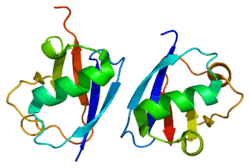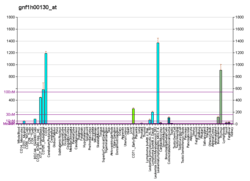UHRF1
Ubiquitin-like, containing PHD and RING finger domains, 1, also known as UHRF1, is a protein which in humans is encoded by the UHRF1 gene.[5][6]
Function
This gene encodes a member of a subfamily of RING-finger type E3 ubiquitin ligases. The protein binds to specific DNA sequences, and recruits the main DNA methyltransferase gene, DNMT1, to regulate chromatin structure and gene expression. Its expression peaks at late G1 phase and continues during G2 and M phases of the cell cycle. It plays a major role in the G1/S transition by regulating topoisomerase II alpha and retinoblastoma gene expression, and functions in the p53-dependent DNA damage checkpoint. Multiple transcript variants encoding different isoforms have been found for this gene.[5]
Clinical significance
UHRF1 has recently been identified as a novel oncogene in hepatocellular carcinoma, the primary type of liver cancer.[7]
References
- 1 2 3 GRCh38: Ensembl release 89: ENSG00000276043 - Ensembl, May 2017
- 1 2 3 GRCm38: Ensembl release 89: ENSMUSG00000001228 - Ensembl, May 2017
- ↑ "Human PubMed Reference:".
- ↑ "Mouse PubMed Reference:".
- 1 2 "Entrez Gene: UHRF1 ubiquitin-like, containing PHD and RING finger domains, 1".
- ↑ Hopfner R, Mousli M, Jeltsch JM, Voulgaris A, Lutz Y, Marin C, Bellocq JP, Oudet P, Bronner C (Jan 2000). "ICBP90, a novel human CCAAT binding protein, involved in the regulation of topoisomerase IIalpha expression". Cancer Research. 60 (1): 121–8. PMID 10646863.
- ↑ http://www.cell.com/cancer-cell/abstract/S1535-6108%2814%2900031-2
Further reading
- Ku DH, Chang CD, Koniecki J, Cannizzaro LA, Boghosian-Sell L, Alder H, Baserga R (Apr 1991). "A new growth-regulated complementary DNA with the sequence of a putative trans-activating factor". Cell Growth & Differentiation. 2 (4): 179–86. PMID 1868030.
- Hillier LD, Lennon G, Becker M, Bonaldo MF, Chiapelli B, Chissoe S, Dietrich N, DuBuque T, Favello A, Gish W, Hawkins M, Hultman M, Kucaba T, Lacy M, Le M, Le N, Mardis E, Moore B, Morris M, Parsons J, Prange C, Rifkin L, Rohlfing T, Schellenberg K, Bento Soares M, Tan F, Thierry-Meg J, Trevaskis E, Underwood K, Wohldman P, Waterston R, Wilson R, Marra M (Sep 1996). "Generation and analysis of 280,000 human expressed sequence tags". Genome Research. 6 (9): 807–28. PMID 8889549. doi:10.1101/gr.6.9.807. Check date values in:
|year= / |date= mismatch(help) - Hopfner R, Mousli M, Jeltsch JM, Voulgaris A, Lutz Y, Marin C, Bellocq JP, Oudet P, Bronner C (Jan 2000). "ICBP90, a novel human CCAAT binding protein, involved in the regulation of topoisomerase IIalpha expression". Cancer Research. 60 (1): 121–8. PMID 10646863.
- Hopfner R, Mousli M, Garnier JM, Redon R, du Manoir S, Chatton B, Ghyselinck N, Oudet P, Bronner C (Mar 2001). "Genomic structure and chromosomal mapping of the gene coding for ICBP90, a protein involved in the regulation of the topoisomerase IIalpha gene expression". Gene. 266 (1-2): 15–23. PMID 11290415. doi:10.1016/S0378-1119(01)00371-7.
- Mousli M, Hopfner R, Abbady AQ, Monté D, Jeanblanc M, Oudet P, Louis B, Bronner C (Jul 2003). "ICBP90 belongs to a new family of proteins with an expression that is deregulated in cancer cells". British Journal of Cancer. 89 (1): 120–7. PMC 2394215
 . PMID 12838312. doi:10.1038/sj.bjc.6601068.
. PMID 12838312. doi:10.1038/sj.bjc.6601068. - Citterio E, Papait R, Nicassio F, Vecchi M, Gomiero P, Mantovani R, Di Fiore PP, Bonapace IM (Mar 2004). "Np95 is a histone-binding protein endowed with ubiquitin ligase activity". Molecular and Cellular Biology. 24 (6): 2526–35. PMC 355858
 . PMID 14993289. doi:10.1128/MCB.24.6.2526-2535.2004.
. PMID 14993289. doi:10.1128/MCB.24.6.2526-2535.2004. - Arima Y, Hirota T, Bronner C, Mousli M, Fujiwara T, Niwa S, Ishikawa H, Saya H (Feb 2004). "Down-regulation of nuclear protein ICBP90 by p53/p21Cip1/WAF1-dependent DNA-damage checkpoint signals contributes to cell cycle arrest at G1/S transition". Genes to Cells : Devoted to Molecular & Cellular Mechanisms. 9 (2): 131–42. PMID 15009091. doi:10.1111/j.1356-9597.2004.00710.x.
- Abbady AQ, Bronner C, Trotzier MA, Hopfner R, Bathami K, Muller CD, Jeanblanc M, Mousli M (Dec 2003). "ICBP90 expression is downregulated in apoptosis-induced Jurkat cells". Annals of the New York Academy of Sciences. 1010: 300–3. PMID 15033738. doi:10.1196/annals.1299.052. Check date values in:
|year= / |date= mismatch(help) - Brandenberger R, Wei H, Zhang S, Lei S, Murage J, Fisk GJ, Li Y, Xu C, Fang R, Guegler K, Rao MS, Mandalam R, Lebkowski J, Stanton LW (Jun 2004). "Transcriptome characterization elucidates signaling networks that control human ES cell growth and differentiation". Nature Biotechnology. 22 (6): 707–16. PMID 15146197. doi:10.1038/nbt971. Check date values in:
|year= / |date= mismatch(help) - Trotzier MA, Bronner C, Bathami K, Mathieu E, Abbady AQ, Jeanblanc M, Muller CD, Rochette-Egly C, Mousli M (Jun 2004). "Phosphorylation of ICBP90 by protein kinase A enhances topoisomerase IIalpha expression". Biochemical and Biophysical Research Communications. 319 (2): 590–5. PMID 15178447. doi:10.1016/j.bbrc.2004.05.028.
- Unoki M, Nishidate T, Nakamura Y (Oct 2004). "ICBP90, an E2F-1 target, recruits HDAC1 and binds to methyl-CpG through its SRA domain". Oncogene. 23 (46): 7601–10. PMID 15361834. doi:10.1038/sj.onc.1208053.
- Abbady AQ, Bronner C, Bathami K, Muller CD, Jeanblanc M, Mathieu E, Klein JP, Candolfi E, Mousli M (Aug 2005). "TCR pathway involves ICBP90 gene down-regulation via E2F binding sites". Biochemical Pharmacology. 70 (4): 570–9. PMID 15964557. doi:10.1016/j.bcp.2005.05.012.
- Jeanblanc M, Mousli M, Hopfner R, Bathami K, Martinet N, Abbady AQ, Siffert JC, Mathieu E, Muller CD, Bronner C (Nov 2005). "The retinoblastoma gene and its product are targeted by ICBP90: a key mechanism in the G1/S transition during the cell cycle". Oncogene. 24 (49): 7337–45. PMID 16007129. doi:10.1038/sj.onc.1208878.
- Jenkins Y, Markovtsov V, Lang W, Sharma P, Pearsall D, Warner J, Franci C, Huang B, Huang J, Yam GC, Vistan JP, Pali E, Vialard J, Janicot M, Lorens JB, Payan DG, Hitoshi Y (Dec 2005). "Critical role of the ubiquitin ligase activity of UHRF1, a nuclear RING finger protein, in tumor cell growth". Molecular Biology of the Cell. 16 (12): 5621–9. PMC 1289407
 . PMID 16195352. doi:10.1091/mbc.E05-03-0194. Check date values in:
. PMID 16195352. doi:10.1091/mbc.E05-03-0194. Check date values in: |year= / |date= mismatch(help) - Kimura K, Wakamatsu A, Suzuki Y, Ota T, Nishikawa T, Yamashita R, Yamamoto J, Sekine M, Tsuritani K, Wakaguri H, Ishii S, Sugiyama T, Saito K, Isono Y, Irie R, Kushida N, Yoneyama T, Otsuka R, Kanda K, Yokoi T, Kondo H, Wagatsuma M, Murakawa K, Ishida S, Ishibashi T, Takahashi-Fujii A, Tanase T, Nagai K, Kikuchi H, Nakai K, Isogai T, Sugano S (Jan 2006). "Diversification of transcriptional modulation: large-scale identification and characterization of putative alternative promoters of human genes". Genome Research. 16 (1): 55–65. PMC 1356129
 . PMID 16344560. doi:10.1101/gr.4039406.
. PMID 16344560. doi:10.1101/gr.4039406. - Beausoleil SA, Villén J, Gerber SA, Rush J, Gygi SP (Oct 2006). "A probability-based approach for high-throughput protein phosphorylation analysis and site localization". Nature Biotechnology. 24 (10): 1285–92. PMID 16964243. doi:10.1038/nbt1240.
- Muto M, Fujimori A, Nenoi M, Daino K, Matsuda Y, Kuroiwa A, Kubo E, Kanari Y, Utsuno M, Tsuji H, Ukai H, Mita K, Takahagi M, Tatsumi K (Nov 2006). "Isolation and Characterization of a Novel Human Radiosusceptibility Gene, NP95". Radiation Research. 166 (5): 723–33. PMID 17067204. doi:10.1667/RR0459.1.






